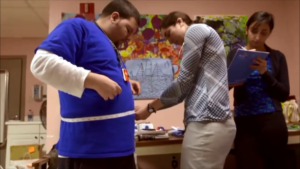The Arc Baton Rouge Flood Impact August 2016
Barry A. Meyer, Executive Director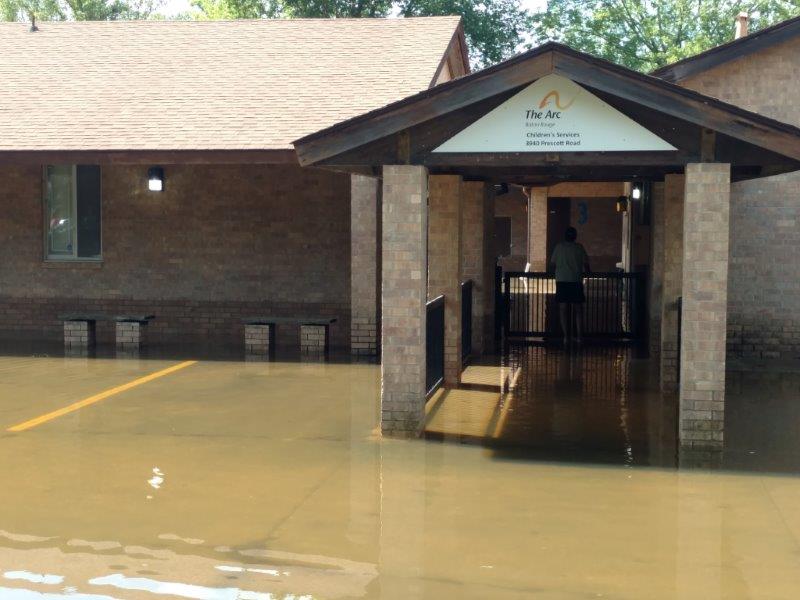
The catastrophic flooding that inundated the greater Baton Rouge and surrounding areas has had a devastating impact on the children, adults and families we serve, as well as our staff. We are still trying to locate some of them.
Fortunately, we located all of the individuals that we directly support who were forced to evacuate from their own homes or apartments. All of them have been moved out of shelters and into shared housing with others who were not flooded. Many of those who live with their families were also forced to evacuate. Some are with other family members that were spared. Some are in area hotels. Others were able to return home once the water subsided. Unfortunately, there are areas that are still flooded. Many staff members have also suffered tremendous losses.
We have yet to locate 2 individuals with IDD and 11 Direct Support Professionals. Of those we have contacted, 60 were forced to evacuate and lost their homes to the flood. Most also lost their vehicles.
Three of our program locations totaling almost 41,000 sq. ft. were flooded;
- Children’s Services Center, the offices and team meeting place for Early Intervention Special Instructors, OTs, PTs and Speech Therapists.
- Metro Enterprises – Prescott Road 1 of 2 locations where crews and enclaves meet before heading to their work site, for others to meet for community volunteer activities, and where our day habilitation services are provided.
- The Respite Care Center for children and adults who are in need of short term residence in a home environment, to relieve family from continual care or in an emergency including instances of abuse or neglect.
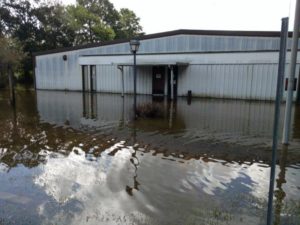
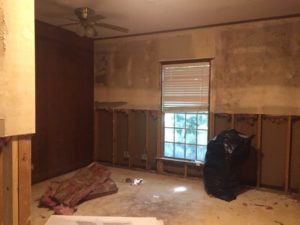
These buildings are located in areas that were mapped as being “safe” from flooding. Like thousands of individuals and businesses in “safe” areas, we did not have flood insurance on these buildings. The maximum water damage coverage we do have is $25,000 per event for ALL property. Repairs and recovery of the Respite Center is a priority because it will provide temporary housing not only for those people we support who are guest in others homes, but for additional folks with IDD who are still in shelters. We received one estimate for repairs for the Respite Center – the smallest of the three flooded facilities – of $167,000.
 We also lost four mini-vans, a full-size automobile used for community inclusion outings, a box truck used to haul paper for shredding contracts and other recyclable goods, and a fork lift.
We also lost four mini-vans, a full-size automobile used for community inclusion outings, a box truck used to haul paper for shredding contracts and other recyclable goods, and a fork lift.
We are overwhelmed by the kind words and encouragement from our friends and extended family of The Arc. Cliff Doescher, the Executive Director of The Arc Greater New Orleans, contacted us almost immediately, offering staff volunteers to help with cleanup and repair efforts. A group of ten will be heading here this Friday and a second group of twelve will be in Baton Rouge next Tuesday.
In a traumatic event of this scale, it is important to reestablish “normal” routines as quickly as possible – for the sake of the children, the adults and their families. As soon as the waters receded, EarlySteps staff resumed seeing children in their homes or other natural settings. Metro staff worked quickly to re-arrange the space at Dallas Drive to make room and accommodate employees and day services clients from the Prescott Road facility. Teamwork and flexibility have minimized our down-time and expedited resumption of services when and wherever possible.
For those who have “lost everything” returning to normal is a long-term goal. A place to sleep is a more urgent priority. I had a chance to visit with many of the staff and individuals we support. I asked, “What would be one thing we can do to help you right now?” Tina thought for only a few seconds and replied, “A mattress, so I could have some place to sleep.”
TIM lived with supports in the same home where he grew up. His sister had remodeled it for him recently, updated with bright new furnishings and total accessibility for his wheelchair. By Friday evening streets in Tim’s neighborhood were flooded, and he and Christy, his day worker, could not get out. With the help of the National Guard they were evacuated by boat to a nearby church shelter on Saturday. As the water continued to rise, they were moved to a high school shelter, where they didn’t stay dry for very long. Christy had to push the wheelchair through the water up to a t-building which was on higher ground. She stood in the water for several hours while holding Tim’s wheelchair on the ramp above the water. When the next boat came they were brought to safety at Central Middle School, where they would finally be dry for the night.
The middle school was a nice facility. There were 2 gyms which allowed shelter volunteers to better accommodate elderly folks and those with disabilities in separate areas; however, all the shelter’s cots were already occupied by other evacuees. Tim got very little sleep sitting upright in his wheelchair. Sunday morning he was moved to a cot, and it goes without saying, he fell fast asleep.
In such a chaotic situation, tracking people down between shelters was no easy task; many people were without cell phone service, and land lines and other utilities were failing by the minute. On top of that… Sunday morning brought the workers’ 4th shift change that had NOT happened. Tim’s Friday daytime DSW was still by his side, caring for him, and unable to get back to be with her own family. They had been completely surrounded by floodwaters with no way in or out.
Amy, Supported Living Program Director, had not given up on finding the two and finally tracked them down at Central Middle School. By this time the water had receded and vehicles were able to drive closer to the school. Amy contacted Barry, Executive Director, to go with her to pick them up. They decided to take Barry’s Jeep because it was several inches higher from the ground than Amy’s van.
Words could not describe the excitement on their faces when Tim and Christy spotted Amy and Barry walking into the gym. But after spending time together and becoming new friends, the shelter volunteers hated to see them go. So what, right? They grabbed the garbage bag with Tim’s personal items, thanked the volunteers, said their good-byes and headed for the door.
Unfortunately The Arc’s Respite Care Center had been flooded, so THE go-to shelter in an emergency or crisis situation was not an option. Right away Amy thought of Lynette, who lives in her own place with full supports. Some might say Lynette is non-verbal, but there was no doubt of her welcoming reply when asked if she would be willing to share her home with Tim, indefinitely! She even volunteered her own bed, equipped with side rail and certain to be the most important amenity to Tim. Even in the comfort of his own home, he rarely slept all night. Sunday. . . Tim slept all night.
BETH AND DONNA each lived on their own in the same apartment complex. They were already friends and occasionally went on outings together. On Saturday when the waters rose from the streets and then into the parking areas of the complex, it seeped into Donna’s home first. No worries… her DSW checked in with Beth’s worker who agreed they should head there. It didn’t take long for the water to rise into Beth’s apartment. They called every single emergency number they could find, and learned that first responders and volunteers were already evacuating the complex, building by building. Beth’s apartment was close to the end of the property, and they waited outside, all night, for their turn to be rescued.
Sunday morning brought with it a rescue boat. Unfortunately one could not choose where they wished to be dropped off. Unloading areas were at random places of highest ground, along a street or other high pavement. Now safe on dry land, the ladies were stranded.
Arc BR Supervisor, Natalie, was relieved to get their call for help. In the past she had worked in a neighborhood near Beth and Donna’s apartment complex, and knew her way around the back roads. She found a route that was not under water, and was able to drive right up to where they stood at the side of the road. She drove them to Mary’s house – another friend in supported Living – who had not been flooded.
Fortunately Mary has a 3rd bedroom in her Habitat for Humanity home that she shares with a housemate. She welcomed Beth and Donna as temporary guests; they share a bedroom, and when possible, the 4 of them share workers.
DURING NORMAL TIMES there are more than enough hotel rooms in and around Baton Rouge to accommodate tourists, business travelers, sports enthusiasts and concert-goers. Several employees of The Arc’s Metro Enterprises Employment Program realized the magnitude of flooding and number of people displaced when they began their search for hotel rooms. Saturday night Byron’s mother finally found a vacant room for 2 nights in Eunice, LA; a small town almost 80 miles away. For 2 days they drove from there into Baton Rouge to begin the cleanup phase of their flood-damaged home, and then back again at night.
Their search for another vacant room took them 110 miles away from home to Alexandria, which is considered central Louisiana. Hopefully Byron and his family have found a place to stay that’s closer to home. And much like tens of thousands of other folks, they continue to work together – gutting and cleaning what’s left of their homes – and determined to rebuild and recover.


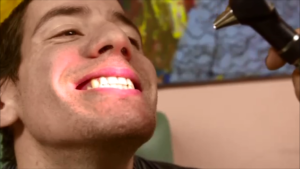 Brian Armour, PhD is an economist with the Centers for Disease Control and Prevention (CDC). He has spent over 15 years in health services research, including work on helping design the
Brian Armour, PhD is an economist with the Centers for Disease Control and Prevention (CDC). He has spent over 15 years in health services research, including work on helping design the 